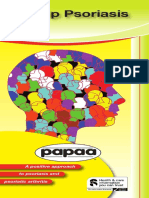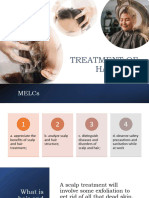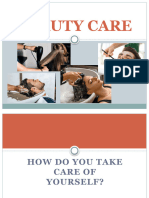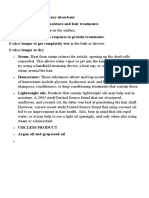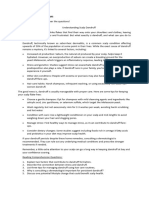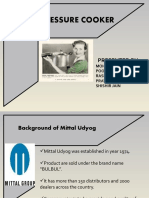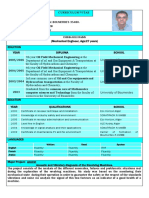Professional Documents
Culture Documents
Formulation and Evaluation of Polyherbal Scalp Scrub
Formulation and Evaluation of Polyherbal Scalp Scrub
Copyright
Available Formats
Share this document
Did you find this document useful?
Is this content inappropriate?
Report this DocumentCopyright:
Available Formats
Formulation and Evaluation of Polyherbal Scalp Scrub
Formulation and Evaluation of Polyherbal Scalp Scrub
Copyright:
Available Formats
Volume 9, Issue 4, April – 2024 International Journal of Innovative Science and Research Technology
ISSN No:-2456-2165 https://doi.org/10.38124/ijisrt/IJISRT24APR908
Formulation and Evaluation of
Polyherbal Scalp Scrub
Gandhi Yash1; Meman Uzer2; Kajal Sahu3; Deeksha Sani4; Ishita Parmar5; Vaishali Pardhe6
B. Pharmacy College Rampura, Panchmahal, Gujarat
Abstract:- Scalp scrub is usually used to treat problems Scalp is the area of the head where head hair grows.
like dead skin cells, dandruff, and flakes, and also The scalp is made up of the skin, connective tissue,
controls sebum imbalance which helps to regulate hair aponeurosis, loose areolar connective tissue, and
growth. This article contains how aloe vera juice, pericranium.
fenugreek granules, rice powder, neem extract, hibiscus The scalp is bordered by the face at the front, and by the
dried powder, optiphen, and lemongrass oil are used in neck at the sides and back.
scalp scrub. The properties of natural ingredients play The scientific study of hair and scalp is called trichology.
an important role in removing impurities from the scalp The scalp plays an important role in the aesthetics of the
and help exfoliate the scalp, balance the sebum, and face.
soften and moisturize the scalp.
C. Types of Scalps
Keywords:- Scalp Scrub, Exfoliate the Scalp, Balance the There are mainly four types of scalps:
Sebum, Soften and Moisturize the Scalp.
Oily Scalp
I. INTRODUCTION Dry Scalp
Normal Scalp
A. Scalp Scrub Combination Scalp
Scalp scrubs are just like body scrubs used to exfoliate
hands and legs, scalp scrubs remove product buildup, dirt, Oily Scalp
excess oil, and dead skin which are gathered at the roots of An oily scalp is a greasy and unmanageable hair. The
the hair. The most important feature of this scalp scrub is it natural oil or sebum the scalp produces keeps hair
exfoliates the scalp. It is especially used to balance the lubricated, shiny, and smooth. However, sometimes the
sebum and helps soothe the scalp. Natural ingredients are scalp can produce too much sebum, resulting in an oily
better than synthetic materials because synthetic materials scalp. The excess oil can lead to an itchy and flaky scalp,
can cause side effects. However, few wastes of natural making the hair look limp and greasy. It can also cause
materials are thrown away because they are considered not clogged pores, leading to scalp acne and dandruff. Genetics,
to provide health benefits. Some of the waste of natural hormonal imbalances, stress, and diet contribute to an oily
ingredients can provide benefits for health, especially to the scalp.
scalp. It also provides a soothing effect, nourishment, and
hair strength, and helps in hair growth. Natural remedies are Dry Scalp
more acceptable in the belief that they are safer with fewer A dry scalp is a common condition that can cause
side effects than synthetic formulations. Herbal formulations discomfort. It occurs when the scalp loses its natural oils,
have a growing demand in the world market. The main making it prone to irritation and itching. Several factors,
advantage of herbal cosmetics is their non-toxic nature, and such as harsh hair products, extreme climatic conditions,
they reduce allergic reactions in the scalp. and hormonal imbalances, can cause a dry scalp. The
symptoms of a dry scalp include dandruff, hair fall, and a
B. Scalp flaky scalp. A dry scalp can be easily treated a dry scalp
with scalp exfoliation.
Normal Scalp
A normal scalp has the right amount of natural oil and
an ideal pH level, thus maintaining a healthy scalp and hair.
The hairs are healthy, shiny, and easy to manage. They may
still experience minor issues like dandruff or an itchy scalp,
but they are usually easily manageable.
Combination Scalp
A combination scalp is a mix of both oily and dry scalp
types. This means some areas of the scalp may be oily while
Fig 1: Anatomy of Scalp others are dry. A combination scalp is similar to a
IJISRT24APR908 www.ijisrt.com 1138
Volume 9, Issue 4, April – 2024 International Journal of Innovative Science and Research Technology
ISSN No:-2456-2165 https://doi.org/10.38124/ijisrt/IJISRT24APR908
combination facial skin. The hair near the scalp is oily, Head Lice Infestation
while the ends of the hair may be dry and brittle. It can be
challenging to manage a combination scalp, but it is possible It is also known as pediculosis capitis, which is the
to achieve healthy and balanced hair with proper care. Using infection of the head hair and scalp by the head louse
gentle and nourishing hair products can help regulate the oil (Pediculus humanus capitis). Itching from lice bites is
production on the scalp while providing moisture to the dry common.
ends. Head lice are spread by direct contact with the hair of
someone who is infected.
D. Scalp-Related Problems The cause of head lice infestations in children is not
related to cleanliness. Other animals, such as cats and
Dandruff dogs, do not play a role in transmission.
Head lice feed only on human blood and are only able to
Dandruff is a skin condition that mainly affects the scalp. survive on human head hair. When adults, they are about
Symptoms include flaking and sometimes mild itchiness. 2 to 3 mm long.
A more severe form of the condition, which includes
inflammation of the skin, is known as seborrheic Seborrheic Dermatitis
dermatitis.
The cause is unclear but believed to involve several It is a long-term skin disorder.
genetic and environmental factors. Symptoms include flaky, scaly, greasy, and occasionally
As the skin layers continually replace themselves, cells itchy and inflamed skin.
are pushed outward where they die and flake off. Areas of the skin rich in oil-producing glands are often
Usually, these flakes of skin are too small to be visible. affected including the scalp, face, and chest.
However, certain conditions cause cell turnover to be Seborrheic dermatitis of the scalp may be described in
unusually rapid, especially in the scalp. lay terms as dandruff due to the dry, flaky character of
The result is that dead skin cells are shed in large, oily the skin.
clumps, which appear as white or grayish flakes on the However, as dandruff may refer to any dryness or
scalp, skin, and clothes. scaling of the scalp, not all dandruff is seborrheic
dermatitis.
Seborrheic dermatitis is sometimes inaccurately referred
to as seborrhoe
II. INGREDIENTS USED IN FORMULATION
A. Ingredients and its Benefits
Table 1: Ingredients with its Benefits
Sr no. Ingredients Benefits of Ingredients
1. Aloe vera extract Promotes hair growth
Reduce dandruff
Strengthens hair
Reduce itchy scalp
Reduce hair loss
2. Fenugreek Stimulate hair growth
Nourishes hair follicle
Increase blood circulation
Remove dead skin
3. Hibiscus powder Conditioners hair
Prevent scalp buildup
Protects from damage
Prevents breakage of hair
Prevent premature greying of hair
4. Neem extract Reduce hair loss
Increase speed of hair growth
Prevents premature greying of hair
Controls sebum
5. Optiphen Used as a preservative
6. Lemon grass oil Control dandruff and aromaticity
IJISRT24APR908 www.ijisrt.com 1139
Volume 9, Issue 4, April – 2024 International Journal of Innovative Science and Research Technology
ISSN No:-2456-2165 https://doi.org/10.38124/ijisrt/IJISRT24APR908
B. Tests Performed During Formulation
Table 2: Tests Performed for Formulation
Ingredients Test 1 Test 2 Test 3 Test 4
Aloe vera extract 5 ml 5 ml 10 ml 10 ml
Fenugreek granules 2g 1g 1.5 g 2g
Rice granules 2g 1g 1.5 g -
Hibiscus powder 2g 1g 1.5 g 2g
Neem extract 10 ml 15 ml 20 ml 22 ml
Optiphen 0.5 ml 1 ml 1.5 ml 2 ml
Lemon grass oil - - 1.5 ml 2 ml
III. METHODS USED IN FORMULATION B. pH test
The pH was measured with a digital pH meter and it
A. Formula 1: (Test 1) was found to be 6.06.
Raw aloe vera gel was extracted and washed, then after
fenugreek and rice granules were grinded into smaller C. Spreadability Test
granules, the hibiscus was collected and dried in the sun for 2 grams of formulated sample was taken and placed on
2-3 days and was powdered, the leaves of neem were kept in a petri dish, another petri plate was then kept on the sample,
water in a beaker and that beaker was kept in a water bath and a 10-gram weight was placed. After 5 minutes the
for 15-20minutes till water colour changes and was then diameter was observed and it was found to be 5 cm.
filtered. The filtrate was taken, mixed with aloe vera extract
and fenugreek granules, rice granules, and hibiscus powder S = m* l / t
were added to the mixture with continuous steering and
optiphen was added as a preservative. Where,
S = Spreadability
B. Formula 2: (Test 2, 3) m = Weight kept on a Petri plate
It was observed that the outcome was not obtained as l = Length budge on glass
desired so the same procedure was done like Formula 1 but t = Time taken
instead, the aloe vera was blended into a mixer first.
S = 10 * 2.5 / 5
C. Formula 3: (Test 4) = 10 * 0.5
It was observed that there was growth of microbial so = 5 cm
the rice granules were removed and the same procedure was
followed as Formula 2. D. Irritancy Test
A small amount of scalp scrub was applied and kept for
IV. EVALUATION OF PRODUCT 5 minutes and irritancy was not observed.
A. Organoleptic Properties E. Washability Test:
A small quantity of scrub was applied over the hair and
Organoleptic properties colour and consistency were scalp, and after 20- 30 minutes should be washed with water
observed visually and it was found to be reddish brown it was observed that the scrub was easily removed by
in colour, paste-like consistency, and aromatic by washing it with water.
olfactory observation.
V. RESULTS
Table 3: Tests
Tests Test 1 Test 2 Test 3 Test 4
Colour Light red Red Reddish brown Reddish brown
Odour Pungent Pungent Slightly aromatic Aromatic
Consistency Coarse texture Paste like Paste like Paste like
pH - - 6.03 6.06
Spreadability - - 4.8 cm 5 cm
Irritancy Non irritant Non irritant Non irritant Non irritant
Washability Easily washable Easily washable Easily washable Easily washable
IJISRT24APR908 www.ijisrt.com 1140
Volume 9, Issue 4, April – 2024 International Journal of Innovative Science and Research Technology
ISSN No:-2456-2165 https://doi.org/10.38124/ijisrt/IJISRT24APR908
VI. CONCLUSION [11]. S. Patel, V. Sharma, N.S Chauhan, M. Thakur & V.K
Dixit, “Hair growth: Focus on Herbal Therapeutic
On observation from all the tests and results it was Agent”, Current drug discovery technologies, 2015,
concluded that the presence of rice causes growth of fungus Volume 12, Issue 1, PP: 21-42.
which is not acceptable and hence when rice was not used in [12]. S. Park & J. Lee, “Modulation of hair growth
formulation it gave the desired outcomes. On applying this promoting effect by natural products”,
scalp scrub, there was a gradual decrement in dandruff and Pharmaceutics, 2021, Volume 13, Issue 12, PP: 2163.
it also didn’t cause any irritancy effect on sensitive skin, it [13]. H. L. Halliday, “Surfactants: past, present and
also makes the hair smooth and no hair loss was observed. future”, Journal of Perinatology, 2008 Volume 28,
Issue 1, PP: S47–S56.
REFERENCES [14]. S. De, S. Malik, A. Ghosh, R. Saha, and B. Saha, “A
review on natural surfactants”, Royal Society of
[1]. Satish D. Mandake, Roshan K. Gavit, “A review on Chemistry Advances, 2015, Volume 5, Issue 81, PP:
herbal hair scrub for hair problem”, International 65757– 65767.
Journal for Research in Applied Science and [15]. P. Johnson, A. Trybala, V. Starov, and V. J. Pinfield,
Engineering Technology, 2024, Volume 4, Issue 2, “Effect of synthetic surfactants on the environment
PP: 443-450. and the potential for substitution by biosurfactants,”
[2]. Yogesh S. Kolekar, Sajid A. Mulari, “Medical plants Advances in Colloid and Interface Science, 2021,
used in cosmetics for skin and hair care”, Volume 28, Issue 8, PP: 102340.
International Journal of Pharmaceutical Chemistry [16]. S. Akbari, N. H. Abdurahman, R. M. Yunus, F.
and Analysis, 2021, Volume 8, Issue 2, PP: 36-40. Fayaz, and O. R. Alara, “Biosurfactants—a new
[3]. Forschende Komplerautnmedizin and Klarsische frontier for social and environmental safety: a
Natur Lei Kunde, “Anti-dandruff hair tonic minireview,” Biotechnology Research of Innovation,
containing lemon grass oil”, Research in 2018, Volume 2, Issue 1, PP: 81-90.
Complementary and Classical Natural Medicine, [17]. S. A. Adu, P. J. Naughton, R. Marchant, and I. M.
2015, Volume 22, Issue 4), PP: 226-229. Banat, “Microbial Biosurfactants in Cosmetic and
[4]. Tanvi Jogalekar, Sharvari Joshi, Dhananjay Joshi, Personal Skincare Pharmaceutical Formulations,”
Vishal Joshi, Rohan Kadam, Snehal Chakorkar, Journal of Pharmaceutics, 2020, Volume 12, Issue 11,
“Natural Foaming Agent”, International Journal of PP: 1099.
Creative Research Thoughts, 2023, Volume 11, Issue [18]. B. G. Ribeiro, J. M. C. Guerra, and L. A. Sarubbo,
5 May 2023, PP: 192-204. “Biosurfactants: Production and application
[5]. Tanvi Jogalekar, Sharvari Joshi, Dhananjay Joshi, prospects in the food industry,” Journal of
Vishal Joshi, Rohan Kadam, Snehal Chakorkar, Biotechnology Progress, 2020, Volume 36, Issue 5,
“Natural Foaming Agent”, International Journal of PP: 168.
Creative Research Thoughts, 2023, Volume 11, Issue [19]. H. L. Halliday, “Surfactants: past, present and
5, PP: 192-204. future,” Journal of Perinatology, 2008, Volume 28,
[6]. Kajal Kesare, Urja Tawri, Manali Barai, Gaurav Issue 1, PP: S47-S56.
Parmal, Dr. Mitali Bodhankar, “Use of rice water [20]. P. Kumar, A. Janardhan, S. Radha, B. Viswanath, and
(Oryza sativa) and hibiscus (Hibiscus rosa-sinensis) G. Narasimha, “Statistical approach to optimize
for hair nutrition and hair growth”, Journal of production of biosurfactant by Pseudomonas
Emerging Technologies and Innovative Research, aeruginosa 2297”, Journal of Biotechnology, 2015,
2021, Volume-8, Issue 6, PP: 2349-5161. Volume 5, Issue 1, PP: 71-79.
[7]. Prachi D. Barsagade, Pranali Patil and Dr. Milind J. [21]. D. Santos, R. Rufino, J. Luna, V. Santos, and L.
Umekar, “A formulation of face pack and hair Sarubbo, “Biosurfactants: Multifunctional
products of rice water for the use of face and hair Biomolecules of the 21st Century,” Internation
problem”, World Journal of Pharmacy and Journal of Molecular Sciences, 2016 Volume 17,
Pharmaceutical Science, 2020, Vol. 9, Issue 4, PP: Issue 3, PP: 401
683-694. [22]. L. A. Sarubbo, R. B. Rocha, J. M. Luna, R. D.
[8]. Ranganathan S. and Mukopadhyay T., “Dandruff: the Rufino, V. A. Santos, and I. M. Banat, “Some aspects
most commercially exploited skin disease”, Indian of heavy metals contamination remediation and role
Journal of Dermatology, 2010, Volume 55, Issue 2, of biosurfactants,” Journal of Chemical Ecology,
PP: 130134. 2015, Volume 31, Issue 8, PP: 707723.
[9]. Lin R.L, Garibyan L, Kimball & L.A Drake, [23]. V. S. Nagtode et al., “Green Surfactants
“Systemic causes of hair loss”, Annals of Medicine, (Biosurfactants): A Petroleum-Free Substitute for
2016, Volume 48, Issue 6, PP: 393-402. Sustainability─Comparison, Applications, Market,
[10]. P. Yesudian, “Human Hair- an evolutionary relic?”, and Future Prospects,” American Chemical Society
International Journal of Trichology, 2011, Volume 3, Omega, 2023, Volume 8, Issue 13, PP: 11674-11699.
Issue 2, PP: 69.
IJISRT24APR908 www.ijisrt.com 1141
You might also like
- Facial Gains Guide (001 081)Document81 pagesFacial Gains Guide (001 081)Goku Pelon92% (12)
- Hair Care Tips For High Porosity HairDocument10 pagesHair Care Tips For High Porosity HairJuanGuillermoCarmonaOcampo0% (1)
- Natural Hair Recipes For Moisture and Growth: Step By Step Instructions On How To Create and Apply Conditioners, Creams, Oils, and Treatments For Dry, Curly, Kinky Afrocentric HairFrom EverandNatural Hair Recipes For Moisture and Growth: Step By Step Instructions On How To Create and Apply Conditioners, Creams, Oils, and Treatments For Dry, Curly, Kinky Afrocentric HairRating: 4.5 out of 5 stars4.5/5 (3)
- Grooming ModuleDocument79 pagesGrooming ModuleAshutosh Sharma100% (1)
- 5 of The Best Essential Oils For HairDocument13 pages5 of The Best Essential Oils For HairJyoti ShindeNo ratings yet
- Hair CareDocument23 pagesHair Careapi-3736205100% (2)
- Ultimate Guide To Managing Frizzy Hair - SkinKraftDocument7 pagesUltimate Guide To Managing Frizzy Hair - SkinKraftPriya PatelNo ratings yet
- Benefits of Scalp and Hair Treatment SLKDocument24 pagesBenefits of Scalp and Hair Treatment SLKRica VillaNo ratings yet
- A Gentleman's Guide For Middle Class Men - CompressedDocument72 pagesA Gentleman's Guide For Middle Class Men - CompressedAbhishek KumarNo ratings yet
- Natural Hair Porosity: All About Moisture & HydrationFrom EverandNatural Hair Porosity: All About Moisture & HydrationRating: 4 out of 5 stars4/5 (1)
- Forex Trading For Beginners PDFDocument30 pagesForex Trading For Beginners PDFCostea Stefan25% (4)
- PLDT v. City of BalangaDocument6 pagesPLDT v. City of BalangaPaul Joshua SubaNo ratings yet
- 9 Hair CleanseDocument11 pages9 Hair CleanseSeetha ChimakurthiNo ratings yet
- Hair ShampoooDocument17 pagesHair ShampoooCherie Banzon100% (1)
- Week 4 Monitoring SystemsDocument19 pagesWeek 4 Monitoring SystemskongNo ratings yet
- Scalp and Hair Treatment (Prepare Client) : Week 2Document12 pagesScalp and Hair Treatment (Prepare Client) : Week 2Yanna ZabateNo ratings yet
- Scalp PsoriasisDocument12 pagesScalp Psoriasisgalih senoajiNo ratings yet
- 5chapter 1 - Hair TrichologyDocument7 pages5chapter 1 - Hair TrichologyGupta Shekhar Sulabh80% (5)
- TLE Hairdressing Grade 8 - 9Document25 pagesTLE Hairdressing Grade 8 - 9Roswlle50% (2)
- Benefits of Hair and Scalp CareDocument28 pagesBenefits of Hair and Scalp Carecherry d.bandola100% (1)
- Enterprise SAP GRC Compliance and Security TrainingDocument128 pagesEnterprise SAP GRC Compliance and Security TrainingT. LyNo ratings yet
- Group 2 Act 5Document6 pagesGroup 2 Act 5Quezza Phola S PatulinNo ratings yet
- Beauty Culture-HairDocument7 pagesBeauty Culture-HairAkshay Nitesh GuptaNo ratings yet
- Your Hair can Mean a Lot-All About Hair Care-An Illustrated BookFrom EverandYour Hair can Mean a Lot-All About Hair Care-An Illustrated BookNo ratings yet
- TLE Hairdressing Grade 8 9 Exp. CourseDocument25 pagesTLE Hairdressing Grade 8 9 Exp. CourseMTesa Esteban100% (1)
- Week 1 Grade 10 Tle Hair DressingDocument4 pagesWeek 1 Grade 10 Tle Hair DressingIsrael Marquez50% (2)
- Hair DandruffDocument4 pagesHair DandruffChandraveer KunwarNo ratings yet
- Hair and Scalp Week 1Document13 pagesHair and Scalp Week 1Johndale RamirezNo ratings yet
- 4236 FC Dandruff - EkioskDocument4 pages4236 FC Dandruff - EkioskSatyajit TripathyNo ratings yet
- Dandruff SolutionDocument5 pagesDandruff SolutionKiran KhanNo ratings yet
- Hairdressing L1-2Document17 pagesHairdressing L1-2Earl YiNo ratings yet
- Beauty Care ResearchDocument11 pagesBeauty Care ResearchGlaiza Dalayoan Flores100% (1)
- Natural Peel-Off Mask Formulation and EvaluationDocument6 pagesNatural Peel-Off Mask Formulation and EvaluationInternational Journal of Innovative Science and Research TechnologyNo ratings yet
- Herbal Hair Care - VPCDocument27 pagesHerbal Hair Care - VPCSatyam DarjiNo ratings yet
- g9 4th Beauty CareDocument132 pagesg9 4th Beauty CarePrimrose MazoNo ratings yet
- Hair Product Formation - Project ProposalDocument4 pagesHair Product Formation - Project ProposalLee ViramNo ratings yet
- GAS Notes FINALS CompleteDocument7 pagesGAS Notes FINALS Completebevienlynpepito10No ratings yet
- Shampoo Updated With Hair OilDocument71 pagesShampoo Updated With Hair OilGaurav MudaduNo ratings yet
- Thesis ProposalDocument14 pagesThesis ProposalCho Yayaen Pingawan100% (4)
- HumanbodyDocument6 pagesHumanbodyapi-318703645No ratings yet
- 8 Best Herbs For Natural Skin CareDocument2 pages8 Best Herbs For Natural Skin CarekatNo ratings yet
- m2 Hair Care ProductsDocument9 pagesm2 Hair Care ProductsKarren ReyesNo ratings yet
- Seborrhoeic Dermatitis in Adults Dec 22 1Document3 pagesSeborrhoeic Dermatitis in Adults Dec 22 1defowar249No ratings yet
- Hair Shampoo and Cleansing Bed BathDocument32 pagesHair Shampoo and Cleansing Bed BathAngel RodriguezNo ratings yet
- 5 Hairloss and DandruffDocument32 pages5 Hairloss and DandruffLQYNo ratings yet
- Ebook HairLossEssentialsDocument158 pagesEbook HairLossEssentialsabhiNo ratings yet
- The Active Head & Shoulders Shampoo IngredientsDocument18 pagesThe Active Head & Shoulders Shampoo IngredientsDipinder KalsiNo ratings yet
- CosmoDocument163 pagesCosmoTadtad FunfunNo ratings yet
- Secret Facial Features EbooksDocument369 pagesSecret Facial Features Ebooksatharv.loginNo ratings yet
- Hygiene ProjectDocument9 pagesHygiene Projectnomehnelson626No ratings yet
- 4 203567156179239592 PDFDocument47 pages4 203567156179239592 PDFGg KNo ratings yet
- ShampoooorecipeDocument5 pagesShampoooorecipefunmi maryNo ratings yet
- Tricology WordDocument26 pagesTricology WordDrushti KadamNo ratings yet
- Low Porosity Hair Tips EtcDocument1 pageLow Porosity Hair Tips EtcParisa SinghNo ratings yet
- Reading For HairstylistDocument2 pagesReading For Hairstylistekasusanty61No ratings yet
- Chapter 1Document4 pagesChapter 1Aileen PamulaklakinNo ratings yet
- Hairdressing G-10: NameDocument7 pagesHairdressing G-10: NameJay Mark PahapayNo ratings yet
- Stunted HairDocument38 pagesStunted HairChidinma NnamaniNo ratings yet
- Personal HygieneDocument5 pagesPersonal HygieneGissele AbolucionNo ratings yet
- Lushomo's PresentationDocument17 pagesLushomo's Presentationsinyangwendanji1No ratings yet
- Oily SkinDocument55 pagesOily SkinmanojbhappaNo ratings yet
- General Biology 2Document13 pagesGeneral Biology 2Kathleen Joice QuijanoNo ratings yet
- Description of SkinDocument17 pagesDescription of SkinAbdur RaquibNo ratings yet
- Human Resource Functions: Examining Insights from ABC Research OrganizationDocument9 pagesHuman Resource Functions: Examining Insights from ABC Research OrganizationInternational Journal of Innovative Science and Research TechnologyNo ratings yet
- Conceptualized Fusion Reactor based on Gas Turbine with High Temperature CO2Document7 pagesConceptualized Fusion Reactor based on Gas Turbine with High Temperature CO2International Journal of Innovative Science and Research TechnologyNo ratings yet
- The Expanding Attack Surface: Securing AI and Machine Learning Systems in Security OperationsDocument8 pagesThe Expanding Attack Surface: Securing AI and Machine Learning Systems in Security OperationsInternational Journal of Innovative Science and Research Technology100% (1)
- Personal Capabilities of The Non-Teaching Personnel and Client SatisfactionDocument8 pagesPersonal Capabilities of The Non-Teaching Personnel and Client SatisfactionInternational Journal of Innovative Science and Research TechnologyNo ratings yet
- The Impact of the Commercial Agriculture Credit Scheme (CACS) on the Agricultural Economy of Nigeria and its Total Output (2015-2019)Document8 pagesThe Impact of the Commercial Agriculture Credit Scheme (CACS) on the Agricultural Economy of Nigeria and its Total Output (2015-2019)International Journal of Innovative Science and Research TechnologyNo ratings yet
- Teacher-Induced Academic Stress: Predicting Eating Behavior Problems in College StudentsDocument8 pagesTeacher-Induced Academic Stress: Predicting Eating Behavior Problems in College StudentsInternational Journal of Innovative Science and Research TechnologyNo ratings yet
- Modern Approaches to Sustainable AgricultureDocument10 pagesModern Approaches to Sustainable AgricultureInternational Journal of Innovative Science and Research Technology100% (1)
- Integrating Quantum Algorithms with Gravitational-Wave Metrology for Enhanced Signal DetectionDocument18 pagesIntegrating Quantum Algorithms with Gravitational-Wave Metrology for Enhanced Signal DetectionInternational Journal of Innovative Science and Research Technology100% (1)
- Utilizing Chicken Eggshells and Waste Glass Powder as Cement Fillers for Environmental StabilityDocument6 pagesUtilizing Chicken Eggshells and Waste Glass Powder as Cement Fillers for Environmental StabilityInternational Journal of Innovative Science and Research TechnologyNo ratings yet
- The Impact of Termite Activity on the Availability of Soil Micronutrients in Tropical RegionsDocument6 pagesThe Impact of Termite Activity on the Availability of Soil Micronutrients in Tropical RegionsInternational Journal of Innovative Science and Research Technology100% (1)
- Assessment of Integrated Poultry Manure and Synthetic Fertilizer Effects on Maize (Zea mays) Growth and Soil Properties: A Study from Bayero University, KanoDocument15 pagesAssessment of Integrated Poultry Manure and Synthetic Fertilizer Effects on Maize (Zea mays) Growth and Soil Properties: A Study from Bayero University, KanoInternational Journal of Innovative Science and Research Technology100% (1)
- Study of prevalence of Head Lice (Pediculus Humanus Capitis) Among Schoolchildren in the Zawiya Region, LibyaDocument10 pagesStudy of prevalence of Head Lice (Pediculus Humanus Capitis) Among Schoolchildren in the Zawiya Region, LibyaInternational Journal of Innovative Science and Research Technology0% (1)
- Transforming Challenges to Victories: An Inquiry on Transformational Leadership of School Leaders in the Public Elementary SchoolsDocument54 pagesTransforming Challenges to Victories: An Inquiry on Transformational Leadership of School Leaders in the Public Elementary SchoolsInternational Journal of Innovative Science and Research TechnologyNo ratings yet
- Meta Land: Redefining Virtual Communities Through Centralized Governance, Inclusivity and InnovationDocument5 pagesMeta Land: Redefining Virtual Communities Through Centralized Governance, Inclusivity and InnovationInternational Journal of Innovative Science and Research TechnologyNo ratings yet
- Development of Smart Ground Fault Location Model For Radial Distribution SystemDocument14 pagesDevelopment of Smart Ground Fault Location Model For Radial Distribution SystemInternational Journal of Innovative Science and Research TechnologyNo ratings yet
- Solar Based Multilevel Inverter F o R BLDC Motor DriveDocument8 pagesSolar Based Multilevel Inverter F o R BLDC Motor DriveInternational Journal of Innovative Science and Research TechnologyNo ratings yet
- Design and Development of Multi-Featured Medical StretcherDocument4 pagesDesign and Development of Multi-Featured Medical StretcherInternational Journal of Innovative Science and Research TechnologyNo ratings yet
- The Influence of Continuance Commitment on Job Satisfaction of Barangay Health Workers in Malaybalay City, BukidnonDocument14 pagesThe Influence of Continuance Commitment on Job Satisfaction of Barangay Health Workers in Malaybalay City, BukidnonInternational Journal of Innovative Science and Research TechnologyNo ratings yet
- Seasonal Variation and Distribution Patterns of Endophytic Community in Withania SomniferaDocument7 pagesSeasonal Variation and Distribution Patterns of Endophytic Community in Withania SomniferaInternational Journal of Innovative Science and Research TechnologyNo ratings yet
- Exploring The Potential Advantages of Traditional Therapies in Autoimmune Blistering Illnesses: A Comprehensive Review and Analysis, ResearchDocument12 pagesExploring The Potential Advantages of Traditional Therapies in Autoimmune Blistering Illnesses: A Comprehensive Review and Analysis, ResearchInternational Journal of Innovative Science and Research TechnologyNo ratings yet
- Intelligent Clinical Documentation: Harnessing Generative AI For Patient-Centric Clinical Note GenerationDocument15 pagesIntelligent Clinical Documentation: Harnessing Generative AI For Patient-Centric Clinical Note GenerationInternational Journal of Innovative Science and Research TechnologyNo ratings yet
- Strategic Deployment of Ducklink Wireless Devices For Disaster Mitigation and Management in Nueva ECIJA University of Science and Technology Sumacab CampusDocument13 pagesStrategic Deployment of Ducklink Wireless Devices For Disaster Mitigation and Management in Nueva ECIJA University of Science and Technology Sumacab CampusInternational Journal of Innovative Science and Research TechnologyNo ratings yet
- Skin Disease Detection and Remedial SystemDocument7 pagesSkin Disease Detection and Remedial SystemInternational Journal of Innovative Science and Research TechnologyNo ratings yet
- Application of Plant Growth Promoting Rhizobacteria On Vegetative Growth in Chili Plants (Capsicum Frutescens L.)Document7 pagesApplication of Plant Growth Promoting Rhizobacteria On Vegetative Growth in Chili Plants (Capsicum Frutescens L.)International Journal of Innovative Science and Research TechnologyNo ratings yet
- Reading Intervention Through "Brigada Sa Pagbasa": Viewpoint of Primary Grade TeachersDocument3 pagesReading Intervention Through "Brigada Sa Pagbasa": Viewpoint of Primary Grade TeachersInternational Journal of Innovative Science and Research TechnologyNo ratings yet
- Unlocking Sentiments: Enhancing IOCL Petrol Pump ExperiencesDocument8 pagesUnlocking Sentiments: Enhancing IOCL Petrol Pump ExperiencesInternational Journal of Innovative Science and Research TechnologyNo ratings yet
- EmoConnect: Nurturing Trust and Relationship Bonds in Alzheimer's ConversationsDocument3 pagesEmoConnect: Nurturing Trust and Relationship Bonds in Alzheimer's ConversationsInternational Journal of Innovative Science and Research TechnologyNo ratings yet
- Fall Detection and Boundary Detection in Care HomesDocument7 pagesFall Detection and Boundary Detection in Care HomesInternational Journal of Innovative Science and Research TechnologyNo ratings yet
- Smart and Secure Home With ChatbotDocument9 pagesSmart and Secure Home With ChatbotInternational Journal of Innovative Science and Research TechnologyNo ratings yet
- Preparation and Identification of Magnetic Iron Nanoparticle Based On A Natural Hydrogel and Its Performance in Targeted Drug DeliveryDocument17 pagesPreparation and Identification of Magnetic Iron Nanoparticle Based On A Natural Hydrogel and Its Performance in Targeted Drug DeliveryInternational Journal of Innovative Science and Research TechnologyNo ratings yet
- PIA Insurance Rating GuideDocument79 pagesPIA Insurance Rating GuideErnestNo ratings yet
- SPE-122292-MS-P Inflow Performance Relationships For Heavy Oil-UnprotectedDocument17 pagesSPE-122292-MS-P Inflow Performance Relationships For Heavy Oil-Unprotectedmoncho000100% (1)
- Chem Assignment-1Document6 pagesChem Assignment-1Daniel ConcessaoNo ratings yet
- Augment Learning - BEED 16Document12 pagesAugment Learning - BEED 16joy pamorNo ratings yet
- Bulbul Pressure Cooker: Presented ByDocument13 pagesBulbul Pressure Cooker: Presented ByPraveen MayarNo ratings yet
- 3.sn-50user Manual V1.0-Update 1406 16 (604) .SignedDocument56 pages3.sn-50user Manual V1.0-Update 1406 16 (604) .SignedModmedmoNo ratings yet
- Sip FileDocument75 pagesSip FileRahul SoroutNo ratings yet
- Letter by Lehman Whistle Blower Matthew Lee, Dated May 16, 2008Document3 pagesLetter by Lehman Whistle Blower Matthew Lee, Dated May 16, 2008DealBookNo ratings yet
- Sunshinerecorder 160926041406Document10 pagesSunshinerecorder 160926041406AndreasKNo ratings yet
- OMZIL MID YEAR 2021 FINANCIAL RESULTS FINAL From Lawrence 31AUG21Document10 pagesOMZIL MID YEAR 2021 FINANCIAL RESULTS FINAL From Lawrence 31AUG21Mandisi MoyoNo ratings yet
- Ibs Mib Al-Idrus 1 31/03/21Document7 pagesIbs Mib Al-Idrus 1 31/03/21warfear88No ratings yet
- Mwananchi Guide For FY 2022 23 PDFDocument16 pagesMwananchi Guide For FY 2022 23 PDFSilla MunyakaNo ratings yet
- The Heritage of Antonio SerraDocument16 pagesThe Heritage of Antonio SerraManuelNo ratings yet
- Gerard Dumenil and Dominique Levy - Neoliberalism and Its CrisisDocument15 pagesGerard Dumenil and Dominique Levy - Neoliberalism and Its CrisisStipe ĆurkovićNo ratings yet
- Philacor Credit Corporation V. Commissioner of Internal RevenueDocument10 pagesPhilacor Credit Corporation V. Commissioner of Internal RevenueCharity Gene AbuganNo ratings yet
- Argumentative EDocument4 pagesArgumentative ELa Ode AlfandiNo ratings yet
- Velilla Vs PosadasDocument7 pagesVelilla Vs PosadasKennethQueRaymundoNo ratings yet
- Apple and Core Competencies 1Document2 pagesApple and Core Competencies 1Jyoti Arvind Pathak0% (1)
- Imc2006@yahoo - FR: Curriculum VitaeDocument8 pagesImc2006@yahoo - FR: Curriculum VitaeFa TiNo ratings yet
- Canon NP6216Document7 pagesCanon NP6216Ioas IodfNo ratings yet
- Read The Following Passage and Choose The Correct Answer.Document27 pagesRead The Following Passage and Choose The Correct Answer.thuymilkNo ratings yet
- International TaxationDocument20 pagesInternational Taxationdhruvi.ksNo ratings yet
- Gpa Proposal FormatDocument3 pagesGpa Proposal FormatMargaret Quiachon ChiuNo ratings yet
- Foreign Exchange Market Notes CHP 3Document2 pagesForeign Exchange Market Notes CHP 3Anamika SonawaneNo ratings yet
- Saudi Aramco Inspection Checklist: Receiving Inspection of Relief Valves SAIC-J-2006 24-Jul-18 MechDocument5 pagesSaudi Aramco Inspection Checklist: Receiving Inspection of Relief Valves SAIC-J-2006 24-Jul-18 Mechnisha_khanNo ratings yet

















